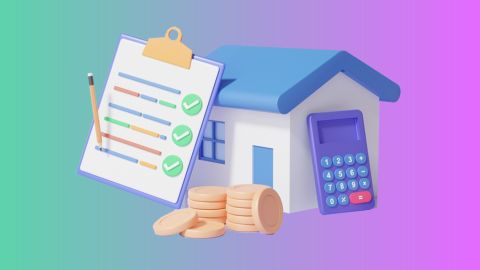Understanding property documentation can be crucial when buying or selling property in India. Among these, the terms 'A Khata' and 'B Khata' often come up. These documents play a pivotal role in property tax assessment and legal ownership status.
The 'A Khata' and 'B Khata' classification stems from the Karnataka Municipal Corporation Act, which categorises properties based on their compliance with building bylaws and other regulations. Knowing the difference between 'A Khata' and 'B Khata' can save you from potential legal hassles and financial setbacks.
For those looking to leverage their property for financial needs, Bajaj Finance offers Loan Against Property. Whether you need funds for education, medical emergencies, or business expansion, you can easily apply for a Loan Against Property with Bajaj Finance. Understanding your property's documentation is vital before proceeding with such financial decisions.
Understand the difference between ‘A Khata’ and ‘B Khata’
The terms 'A Khata' and 'B Khata' represent different categories of property ownership documents. These terms are crucial for property tax payments and legal ownership verification.
What is ‘A Khata’?
'A Khata' refers to a property that complies with all government regulations, including building bylaws, tax payments, and construction approvals. It is an official document issued by the Bruhat Bengaluru Mahanagara Palike (BBMP) that certifies the legal status of a property. An 'A Khata' property is fully authorised for all commercial and non-commercial transactions, making it a preferred choice for buyers and investors.
Importance of ‘A Khata’:
- Legal compliance: Ensures that your property adheres to all legal and regulatory standards.
- Financial security: Facilitates easier approval for loans and mortgages.
- Property value: Enhances the market value of your property.
- Ease of transaction: Simplifies property sales and transfers.
- Government benefits: Eligibility for municipal services and schemes.
What is the difference between ‘A Khata’ and ‘B Khata’?
| Aspect | A Khata | B Khata |
| Legal status | Fully legal and compliant | Non-compliant with certain bylaws |
| Tax payment | Regular tax payments | Irregular or pending tax payments |
| Property transactions | Approved for all transactions | Restrictions on transactions |
| Building approval | Approved building plan | Unapproved or pending approvals |
| Loan eligibility | Eligible for loans and mortgages | Not eligible for formal loans |
| Market value | Higher market value | Lower market value |
How to obtain ‘A Khata’ certificate?
To obtain an 'A Khata' certificate, follow these steps:
- Visit the BBMP office: Go to the nearest BBMP office with your property documents.
- Application form: Fill out the 'A Khata' application form.
- Submit documents: Provide all necessary documents, including tax receipts and property details.
- Verification process: The BBMP will verify your documents and inspect the property if needed.
- Pay fees: Pay the applicable fee for the 'A Khata' certificate.
- Receive certificate: Upon successful verification and fee payment, you will receive your 'A Khata' certificate.
Documents required for ‘A Khata’:
- Sale deed: Original sale deed of the property.
- Tax receipts: Latest property tax receipts.
- Encumbrance certificate: Encumbrance certificate (EC) up to date.
- Occupancy certificate: Occupancy certificate (if applicable).
- Approved building plan: Approved building plan from BBMP.
- ID proof: Valid ID proof of the property owner.
Benefits of having ‘A Khata’:
- Loan eligibility: Easier to secure a loan on property such as Loan Against Property.
- Property transactions: Simplifies selling or leasing the property.
- Legal protection: Protects against legal disputes and penalties.
- Access to services: Eligibility for government schemes and municipal services.
- Market value: Increases the market value of the property.
Process of converting ‘B Khata’ to ‘A Khata’:
Converting 'B Khata' to 'A Khata' involves the following steps:
- Regularise property: Ensure that your property complies with BBMP building bylaws.
- Clear taxes: Pay any outstanding property taxes and penalties.
- Submit application: Submit an application to BBMP for conversion.
- Verification: BBMP will inspect your property and verify compliance.
- Pay conversion fees: Pay the necessary fees for the conversion process.
- Receive ‘A Khata’: After successful verification and fee payment, receive your 'A Khata' certificate.
Legal implications of not having ‘A Khata’
Owning a property without 'A Khata' can lead to several legal issues:
- Limited transactions: You cannot legally sell or transfer the property.
- Loan restrictions: Ineligibility for formal loans and mortgages.
- Penalties: Risk of fines and penalties from municipal authorities.
- Disputes: Increased chances of legal disputes and complications.
- Government services: Ineligibility for certain municipal services and schemes.
Understanding the 'A Khata' meaning and its significance is essential for property owners in Bengaluru. The difference between 'A Khata' and 'B Khata' can impact your property transactions, legal standing, and financial opportunities. For those with 'A Khata' properties, securing a Loan Against Property from Bajaj Finance becomes straightforward and hassle-free. Ensure that your property complies with all regulations to enjoy the benefits and avoid potential legal complications.




